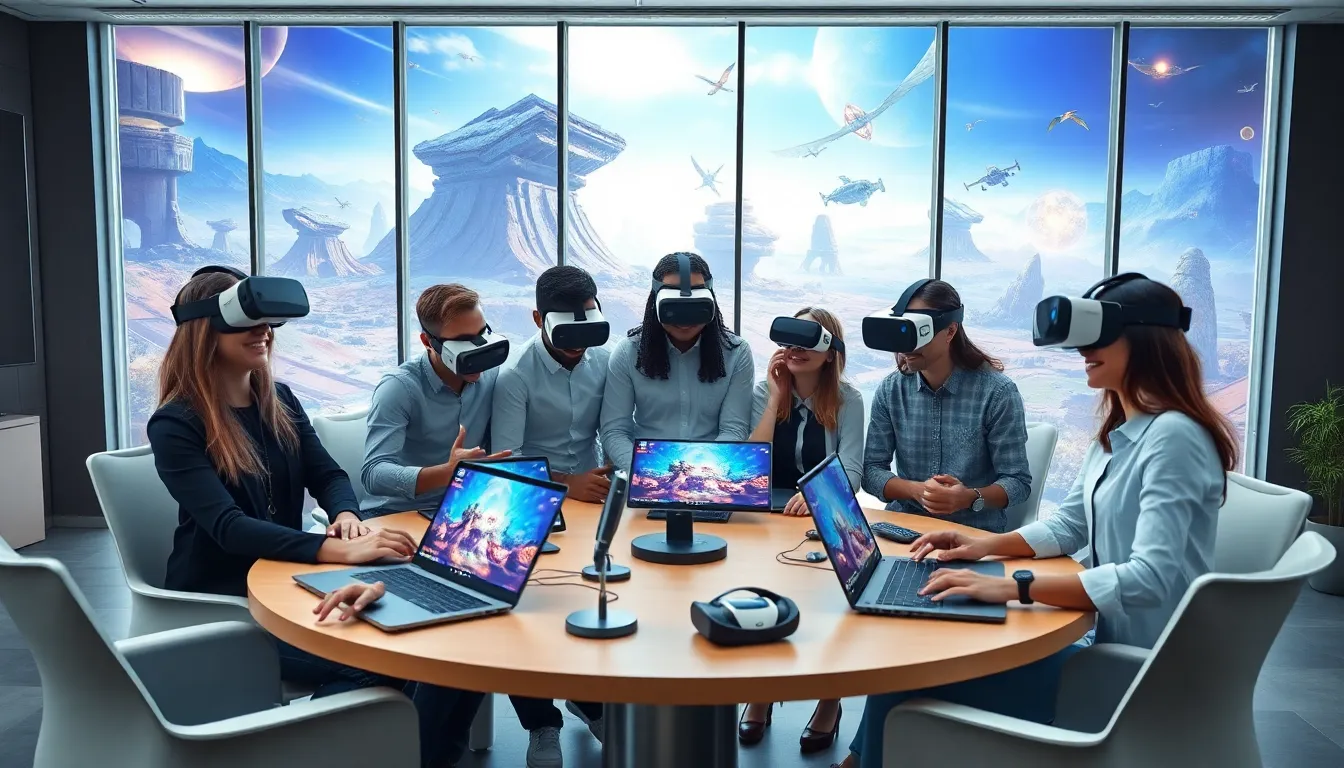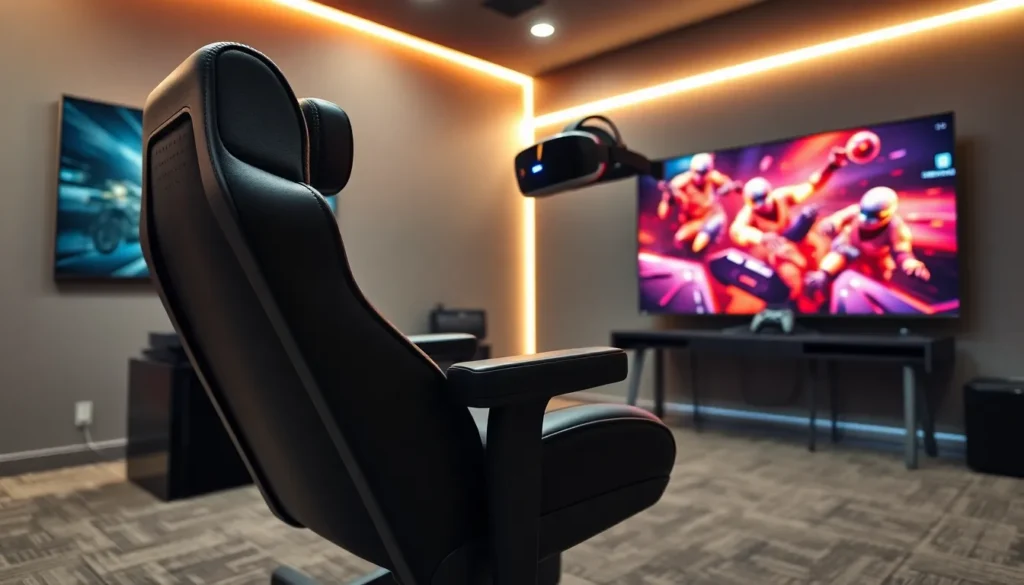Table of Contents
ToggleImagine strapping on a headset and diving into worlds that look, feel, and sound almost real. Welcome to the realm of VR gaming, where your living room transforms into a battlefield, a mystical forest, or even outer space. This industry is booming, with companies pushing technological boundaries faster than you can say “level up.” If you’re curious about who’s behind this captivating magic, buckle up. We’re about to explore the key players and trends shaping the VR landscape, all while keeping it light and entertaining. So, grab your virtual gear and let’s jump in.
Overview of the VR Gaming Industry

The VR gaming industry has grown into a thriving market, with a value well into the billions. What started as a niche hobby has exploded into mainstream entertainment, attracting gamers, developers, and investors alike. Companies are harnessing cutting-edge technology to create experiences that engage users in ways traditional gaming can only dream of.
At the core of this industry lies immersive gameplay. Virtual reality provides an unparalleled sense of presence, plunging players into vividly rendered landscapes. Whether battling foes or solving puzzles, each moment feels tangible. This level of immersion is drawing not only hardcore gamers but also casual players and even those previously uninterested in video games.
In recent years, the industry has seen significant advancements in hardware and software. With the introduction of affordable headsets and powerful gaming consoles, VR has become accessible to a broader audience. As a result, many companies are scrambling to produce compelling content that can retain users’ attention in this ever-evolving arena.
Key Players in VR Gaming
Several companies dominate the VR gaming landscape, each contributing unique experiences and innovations.
1. Oculus: Often synonymous with VR, Oculus, owned by Meta Platforms, leads the market with its flagship Quest series. These headsets offer wireless freedom and a vast library of games, making them a preferred choice for gamers.
2. HTC Vive: Known for its robust tracking capabilities, HTC Vive has carved out a niche with its high-quality hardware and immersive experiences. It’s particularly popular among serious gamers who want the best performance.
3. PlayStation VR: Sony has merged console gaming with VR, offering gamers a platform that isn’t just entertaining but also convenient. The PlayStation VR headset is a gateway for gamers who want to explore virtual worlds without investing heavily in high-end PCs.
4. Valve: With its Steam platform and the Index headset, Valve has developed a community-centered ecosystem that includes some of the most popular VR titles available today. This company recognizes the importance of user engagement and community-driven development.
These names are just a few among many that have played crucial roles in VR’s growth. Their contributions have shaped gaming as we know it and expanded the possibilities of interactive entertainment.
Innovative Technologies in VR Gaming
Technology is advancing at lightning speed, and VR gaming companies are leveraging these innovations to enhance user experience.
1. Eye Tracking: This technology allows for more intuitive gameplay. By tracking where players are looking, games can adjust to provide more personalized and immersive experiences.
2. Haptic Feedback: Companies are implementing advanced haptic technology to simulate sensations and make games feel more lifelike. Whether it’s feeling the wind in your face or shaking from a explosions, this technology adds an extra layer of realism.
3. Spatial Audio: Immersive sound is an essential component of VR. With spatial audio technology, sounds are positioned in a 3D space, allowing players to pinpoint where they’re coming from, enhancing the overall experience.
4. Improved Controllers: New controller designs incorporate motion capture and more precise tracking, allowing for better interaction with the VR environment. This means the movements feel natural, facilitating easier gameplay and deeper immersion.
These innovations aren’t just cool: they’re game-changers. Such technologies propel the industry forward, making VR an essential part of gaming’s future.
Market Trends and Future Outlook
The future of VR gaming looks promising, with several trends signaling exciting developments on the horizon.
1. Increased Social Interaction: As VR technology evolves, so does the opportunity for social gaming. Virtual reality has the potential to create fully immersive social spaces where players can interact as if they were in the same room.
2. Cross-Platform Play: There’s a growing push for more cross-platform experiences. As players want to connect regardless of their devices, companies are working towards developing games that work across various VR headsets and platforms.
3. AR Integration: Augmented Reality (AR) is increasingly blending with virtual experiences, offering hybrid gameplay that could redefine how users engage with their environment.
4. More Diverse Content: With the rise of indie developers and gaming startups, players can expect a broader range of genres, from horror to educational games. This diversification helps attract a wider audience, breaking the stereotype that VR is only for certain types of gamers.
Summarizing, the trajectory of VR gaming points towards richer experiences and broader acceptance, suggesting a future where gaming is more interconnected than ever.
Challenges Facing VR Gaming Companies
While the future is bright, there are various challenges that VR gaming companies must navigate.
1. High Development Costs: Creating immersive VR experiences often requires significant investment. This can put a strain on smaller developers, making it difficult for them to compete against larger companies.
2. Content Saturation: As more games flood the market, distinguishing compelling offerings from mediocre ones becomes increasingly challenging. Players may become overwhelmed, leading to a dilution of innovative titles.
3. Motion Sickness Issues: Many users experience discomfort when using VR. Companies must find ways to minimize motion sickness to ensure gameplay remains enjoyable for all users.
4. Technology Limitations: Even though advancements, many consumers lack ideal hardware. High-quality VR systems can be expensive, which acts as a barrier to entry for potential gamers.
Addressing these hurdles will be critical for the sustained growth of the VR gaming industry. Companies that adapt their strategies will not only thrive but also create richer experiences for players.




